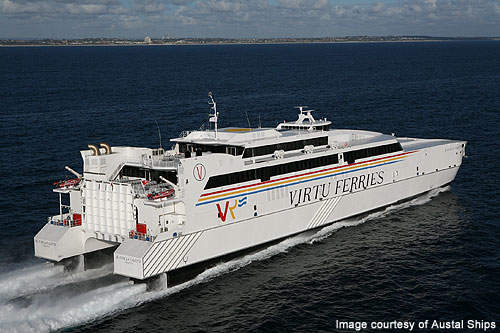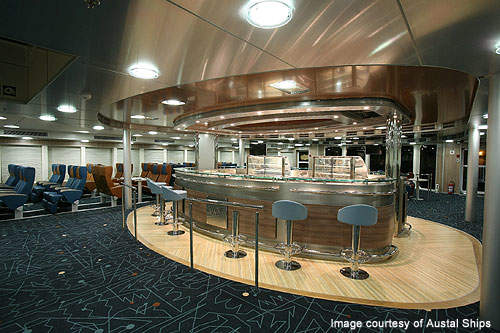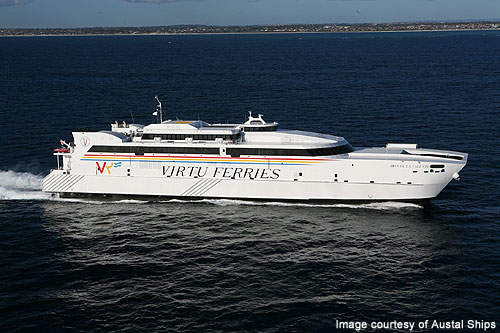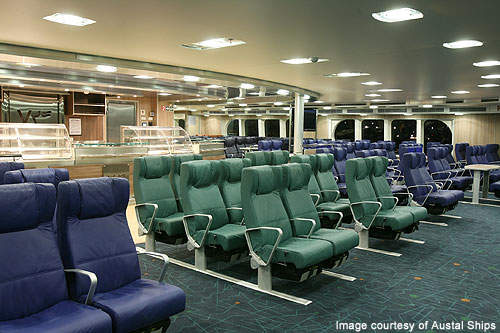Jean de la Valette is a high-speed, all-weather passenger catamaran ferry owned by Virtu Ferries.
It was claimed to be the largest vessel of its kind operating in the Mediterranean when launched in April 2010. The vessel was built to handle the increased cargo and passenger traffic between Malta and Italy.
The Jean de la Valette was deployed on a scheduled three-hour Malta-Sicily route between Valletta, Augusta and Catania in March 2021 on behalf of the Government of Trinidad & Tobago. The vessel joined the M/V Saint John Paul II to serve the ports of Valletta and Pozzallo. It complies with the safety regulations of the International Maritime Organisation and those by the European Union.
The ferry was built by Austal under a contract awarded by Virtu Ferries in April 2009. It is the 24th commercial vessel delivered by Austal to operators in the Mediterranean region.
The vessel was delivered in August 2010 and began its operations in October 2010, replacing Maria Dolores, which was delivered to Virtu Ferries in 2006.
During its delivery trip from Australia to Malta in September 2010, the vessel managed to outrun pirates. Virtu Ferries reported that the incident occurred when the vessel entered the Red Sea through Bab El Mandeb. Pirate skiffs tried to chase but gave up due to the high speed of the vessel.
Jean de la Valette design
Designed by Austal’s in-house design team, Jean de la Valette is capable of shipping 156 cars, or 45 cars and 342m of truck lanes. The vessel can accommodate 800 passengers and 24 crew members. It is designed to operate at a speed of 38.5k.
With an overall length of 106.5m, the vessel has a maximum deadweight of 850t. Its length (waterline) and moulded beam are 92.4m and 23.8m respectively.
The vehicle deck clear height in the centre lane is 4.6m, while that in the side lanes is 4.35m. The maximum draft of the vessel is 4.9m.
The fuel capacity of the vessel is 512t. Maximum axle loads are 15t (dual axle) and 12t (single axle).
Jean de la Valette construction
Jean de la Valette has been built by Austal’s Western Australian workforce in accordance with the requirements of Det Norske Veritas (DNV) safety certification. It is certified to carry dangerous cargo such as LPG, benzene, diesel and petrol.
Since the vessel was bigger than the hall in which it was being constructed, the company had applied its unique modular manufacturing process. The blocks were first fabricated and then fitted-out together. Two cranes were engaged to add the wheelhouse superstructure to the hull.
The hull of the vessel is made up of aluminium. In addition to a stern ramp, the vessel is equipped with a port-side ramp for loading and unloading trucks. To counter adverse weather conditions and increase passenger comfort, the vessel is installed with Austal’s next generation Ride Control System, which makes use of larger T-foil arrangement.
Jean de la Valette Facilities
With a sitting density of two to three seats per row, seats for 800 passengers are arranged on two decks of the vessel.
Over 110 passengers can be accommodated with outdoor seating. The vessel also has a dedicated upper deck lounge area.
The first class seating area features natural overhead lighting, two VIP lounges, and a separate kiosk. The two outside passenger seating areas are located on the Club deck and Euro Class deck.
The vessel also has a dedicated lounge for commercial vehicle drivers. This lounge is fitted with fully reclinable seats supplied by Georg Eknes.
Navigation and communications
The Jean de la Valette is fitted with MantaDigital Radar and an electronic chart display and information system.
The bridge equipment features both the high-performance solid state SharpEye S-band Radar sensors and conventional magnetron. Wide-screen MantaDigital display technology and enhanced target detection provide high performance and reliability to the vessel.
Propulsion
The Jean de la Valette is powered by four MTU 20V 8000 M71L diesel engines.
Each of the 9,100kW engines drives Rolls-Royce Kamewa 125SIII waterjets at 1,150rpm through ZF 53800 NR2H gearboxes.











